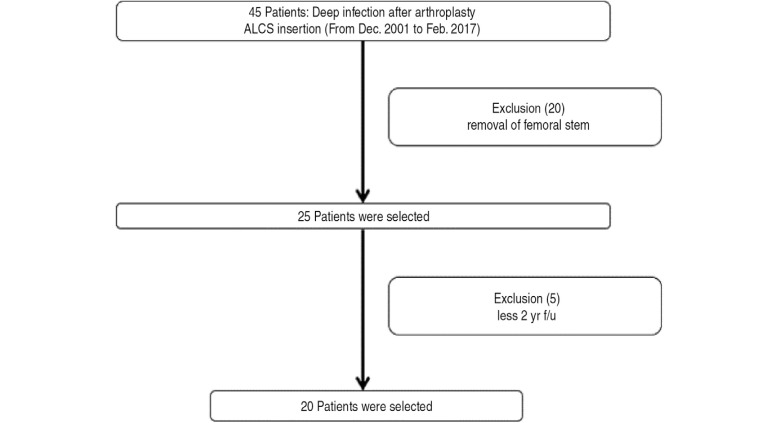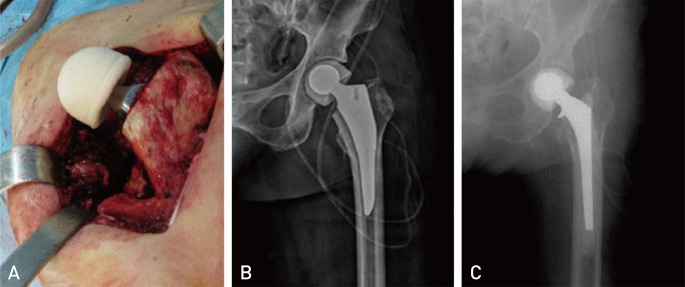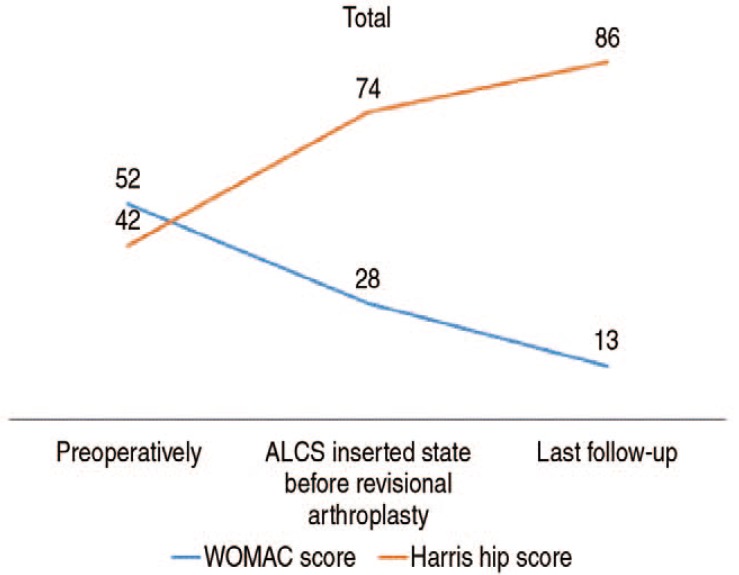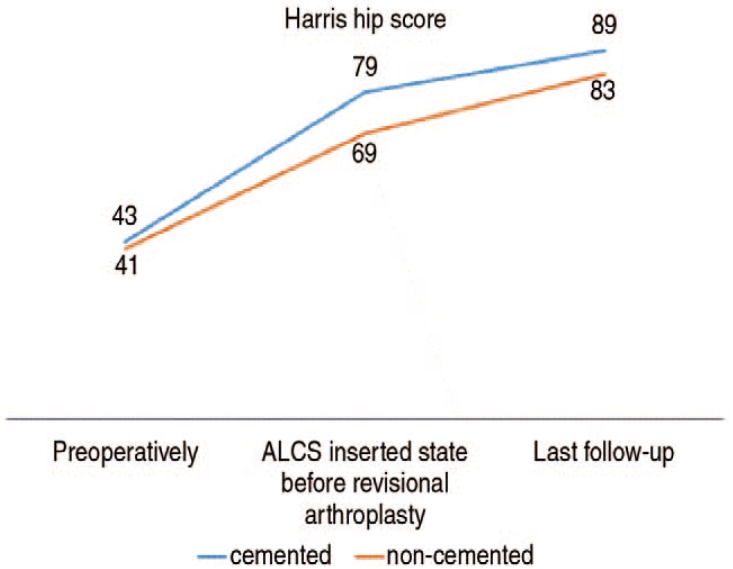Hip Pelvis.
2020 Mar;32(1):26-34. 10.5371/hp.2020.32.1.26.
Staged Revision of Infected-hip Arthroplasty Using an Antibiotics-loaded Intra-articular Cement Spacer: Impact on Cemented and Cementless Stem Retention
- Affiliations
-
- 1Department of Orthopedic Surgery, Sanggye Paik Hospital, Inje University College of Medicine, Seoul, Korea. ybs58@paik.ac.kr
- 2Department of Orthopaedic Surgery, Seoul Paik Hospital, Inje University College of Medicine, Seoul, Korea.
- KMID: 2471128
- DOI: http://doi.org/10.5371/hp.2020.32.1.26
Abstract
- PURPOSE
Currently, standard management of a peri-prosthetic infection is a two-stage revision precedure. However, removal of well-fixed cement is technically demanding and associated with numerous potential complications. For theses reasons, two-stage revision with preservation of the original femoral stem can be considered and several previous studies have achieved successful results. While most prior studies used cemented stems, the use of cementless stems during arthroplasty has been gradually increasing; this study aims to assess the comparative effectiveness of a two-stage revision of infected hip arthroplasties at preserving cemented and cementless stems.
MATERIALS AND METHODS
Between December 2001 and February 2017, Inje University Sanggye Paik Hospital treated 45 cases of deep infections following hip arthroplasty with a two stage revisional arthroplasty using antibiotics-loaded cement spacers. This approach was applied in an effort to preserve the previously implanted femoral stem. Of these 45 cases, 20 were followed-up for at least two years and included in this analysis. Perioperative clinical symptoms, radiological findings, function and complications during insertion of an antibiotics-loaded cement spacer were analyzed in this study.
RESULTS
Peri-prothetic infections were controlled in 19 of the 20 included cases. Clinical outcomes, as assessed using the Harris hip score, Western Ontario and McMaster University score, also improved. Importantly, similarly improved outcomes were achieved for both cemented and cementless femoral stems.
CONCLUSION
In cases of deep infection following hip arthroplasty, two-stage revision arthroplasty to preserve the previously implanted femoral stem (cemented or cementless) effectively controls infections and preserves joint function.
Keyword
MeSH Terms
Figure
Reference
-
1. Canner GC, Steinberg ME, Heppenstall RB, Balderston R. The infected hip after total hip arthroplasty. J Bone Joint Surg Am. 1984; 66:1393–1399. PMID: 6389554.
Article2. Phillips JE, Crane TP, Noy M, Elliott TS, Grimer RJ. The incidence of deep prosthetic infections in a specialist orthopaedic hospital: a 15-year prospective survey. J Bone Joint Surg Br. 2006; 88:943–948. PMID: 16799001.3. Volin SJ, Hinrichs SH, Garvin KL. Two-stage reimplantation of total joint infections: a comparison of resistant and nonresistant organisms. Clin Orthop Relat Res. 2004; (427):94–100.4. Toms AD, Davidson D, Masri BA, Duncan CP. The management of peri-prosthetic infection in total joint arthroplasty. J Bone Joint Surg Br. 2006; 88:149–155. PMID: 16434514.
Article5. Paprosky WG, Weeden SH, Bowling JW Jr. Component removal in revision total hip arthroplasty. Clin Orthop Relat Res. 2001; (393):181–193.
Article6. Lord GA, Hardy JR, Kummer FJ. An uncemented total hip replacement: experimental study and review of 300 madreporique arthroplasties. Clin Orthop Relat Res. 1979; (141):2–16.7. Morley JR, Blake SM, Hubble MJ, Timperley AJ, Gie GA, Howell JR. Preservation of the original femoral cement mantle during the management of infected cemented total hip replacement by two-stage revision. J Bone Joint Surg Br. 2012; 94:322–327. PMID: 22371537.
Article8. Ekpo TE, Berend KR, Morris MJ, Adams JB, Lombardi AV Jr. Partial two-stage exchange for infected total hip arthroplasty: a preliminary report. Clin Orthop Relat Res. 2014; 472:437–448. PMID: 23852737.
Article9. Schmidt J, Porsch M, Sulk C, Hillekamp J, Schneider T. Removal of well-fixed or porous-coated cementless stems in total hip revision arthroplasty. Arch Orthop Trauma Surg. 2002; 122:48–50. PMID: 11995881.
Article10. Lee YK, Lee KH, Nho JH, Ha YC, Koo KH. Retaining well-fixed cementless stem in the treatment of infected hip arthroplasty. Acta Orthop. 2013; 84:260–264. PMID: 23621807.
Article11. Sung YB, Oh JS. Staged revision of infected hip arthroplasty using an antibiotics-loaded intra-articular cement spacer with retention of the stem. J Korean Hip Soc. 2010; 22:66–72.
Article12. Chen KH, Tsai SW, Wu PK, Chen CF, Wang HY, Chen WM. Partial component-retained two-stage reconstruction for chronic infection after uncemented total hip arthroplasty: results of sixteen cases after five years of follow-up. Int Orthop. 2017; 41:2479–2486. PMID: 28550428.
Article13. Parvizi J, Gehrke T. Definition of periprosthetic joint infection. J Arthroplasty. 2014; 29:1331. PMID: 24768547.
Article14. Spangehl MJ, Masri BA, O'Connell JX, Duncan CP. Prospective analysis of preoperative and intraoperative investigations for the diagnosis of infection at the sites of two hundred and two revision total hip arthroplasties. J Bone Joint Surg Am. 1999; 81:672–683. PMID: 10360695.
Article15. Barrack RL, Mulroy RD Jr, Harris WH. Improved cementing techniques and femoral component loosening in young patients with hip arthroplasty. A 12-year radiographic review. J Bone Joint Surg Br. 1992; 74:385–389. PMID: 1587883.
Article16. Harris WH. Traumatic arthritis of the hip after dislocation and acetabular fractures: treatment by mold arthroplasty. An end-result study using a new method of result evaluation. J Bone Joint Surg Am. 1969; 51:737–755. PMID: 5783851.17. Bellamy N, Buchanan WW, Goldsmith CH, Campbell J, Stitt LW. Validation study of WOMAC: a health status instrument for measuring clinically important patient relevant outcomes to antirheumatic drug therapy in patients with osteoarthritis of the hip or knee. J Rheumatol. 1988; 15:1833–1840. PMID: 3068365.18. Buchholz HW, Elson RA, Engelbrecht E, Lodenkämper H, Röttger J, Siegel A. Management of deep infection of total hip replacement. J Bone Joint Surg Br. 1981; 63:342–353. PMID: 7021561.
Article19. Callaghan JJ, Katz RP, Johnston RC. One-stage revision surgery of the infected hip. A minimum 10-year followup study. Clin Orthop Relat Res. 1999; (369):139–143.20. Bittar ES, Petty W. Girdlestone arthroplasty for infected total hip arthroplasty. Clin Orthop Relat Res. 1982; (170):83–87.
Article21. Antti-Poika I, Santavirta S, Konttinen YT, Honkanen V. Outcome of the infected hip arthroplasty. A retrospective study of 36 patients. Acta Orthop Scand. 1989; 60:670–675. PMID: 2624086.
Article22. Balderston RA, Hiller WD, Iannotti JP, et al. Treatment of the septic hip with total hip arthroplasty. Clin Orthop Relat Res. 1987; (221):231–237. PMID: 3608303.
Article23. Lieberman JR, Callaway GH, Salvati EA, Pellicci PM, Brause BD. Treatment of the infected total hip arthroplasty with a two-stage reimplantation protocol. Clin Orthop Relat Res. 1994; (301):205–212. PMID: 8156676.
Article24. Salvati EA, Chekofsky KM, Brause BD, Wilson PD Jr. Reimplantation in infection: a 12-year experience. Clin Orthop Relat Res. 1982; (170):62–75.25. Ivarsson I, Wahlström O, Djerf K, Jacobsson SA. Revision of infected hip replacement. Two-stage procedure with a temporary gentamicin spacer. Acta Orthop Scand. 1994; 65:7–8. PMID: 8154288.
Article26. Younger AS, Duncan CP, Masri BA. Treatment of infection associated with segmental bone loss in the proximal part of the femur in two stages with use of an antibiotic-loaded interval prosthesis. J Bone Joint Surg Am. 1998; 80:60–69. PMID: 9469310.
Article27. Kendall RW, Masri BA, Duncan CP, Beauchamp CP, McGraw RW, Bora B. Temporary antibiotic loaded acrylic hip replacement: a novel method for management of the infected THA. Semin Arthroplasty. 1994; 5:171–177. PMID: 10155160.28. Garvin KL, Hanssen AD. Infection after total hip arthroplasty. Past, present, and future. J Bone Joint Surg Am. 1995; 77:1576–1588. PMID: 7593069.
Article29. Sanchez-Sotelo J, Berry DJ, Hanssen AD, Cabanela ME. Midterm to long-term followup of staged reimplantation for infected hip arthroplasty. Clin Orthop Relat Res. 2009; 467:219–224. PMID: 18813895.
Article30. English H, Timperley AJ, Dunlop D, Gie G. Impaction grafting of the femur in two-stage revision for infected total hip replacement. J Bone Joint Surg Br. 2002; 84:700–705. PMID: 12188488.
Article31. Cordero J, Munuera L, Folgueira MD. Influence of bacterial strains on bone infection. J Orthop Res. 1996; 14:663–667. PMID: 8764878.32. Struhl S, Harwin SF, Stern RE, Kulick RG. Infected uncemented hip arthroplasty. Preserving the femoral stem with a two-stage revision procedure. Orthop Rev. 1989; 18:707–712. PMID: 2664672.33. Yoon TR, Rowe SM, Park CH, Jung SN. Treatment of infected uncemented total hip arthroplasty: two-stage revision procedure by preserving well-fixed femoral components in four cases. J Korean Orthop Assoc. 2000; 35:467–472.
Article34. Gristina AG, Naylor PT, Webb LX. Molecular mechanisms in musculoskeletal sepsis: the race for the surface. Instr Course Lect. 1990; 39:471–482. PMID: 2186137.
- Full Text Links
- Actions
-
Cited
- CITED
-
- Close
- Share
- Similar articles
-
- Staged Revision of Infected Hip Arthroplasty Using an Antibiotics-Loaded Intra-Articular Cement Spacer with Retention of the Stem
- Results of Revision Hip Arthroplasty using Cemented Femoral Stem
- Treatment of Infected uncemented Total Hip Arthroplasty: Two-stage revision procedure by preserving well-fixed femoral components in four cases
- Cemented Total Hip Replacement Arthroplasty
- Long-Term Clinical Outcome of Two Stage Revision Surgery for Infected Hip Arthroplasty Using Cement Spacer







